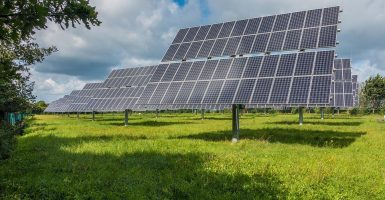US Makes Major Investment In Solar Power Technology, Here’s How It Will Be Used
The Biden Administration made an $80 investment into solar power technology to integrate solar technology into the existing electrical grid, and make clean energy accessible to communities nationwide.

The Biden administration recently announced a bold $80 million investment in solar power technology, signaling a renewed commitment to clean energy in the United States. This investment focuses on increasing solar panel production, expanding solar energy accessibility, and fostering innovation in non-silicon-based solar panels. As a result, the United States’ solar energy sector is poised for significant growth and exciting breakthroughs.
Expanding Solar Panel Production and Accessibility
AP News reports that the Department of Energy (DOE) intends to invest $52 million in 19 solar projects across 12 states while allocating an additional $30 million to technologies that facilitate solar power integration into the grid. This funding aims to boost solar panel production in the United States and make solar energy more accessible, particularly by promoting community solar projects.
Community Solar Projects
Community solar projects enable renters and individuals without control over their rooftops to benefit from solar power. These initiatives allow households to invest in or subscribe to a portion of a more extensive offsite solar array.
According to the AP, the DOE has chosen 25 teams to participate in a $10 million competition to accelerate solar developers’ efforts in solar community projects. The goal is to increase the current 5.3 gigawatts of installed community solar capacity and provide access to community solar for five million households by 2025, saving $1 billion on electricity bills.
Next-generation Solar Technologies
The Biden administration’s investment supports the development of next-generation solar technologies, such as perovskite and cadmium telluride (CdTe) solar cells. These alternatives to traditional silicon-based solar panels offer the potential for improved solar energy efficiency and cost-effectiveness.
Perovskite solar cells can be produced more affordably than silicon, are more defect-tolerant, and can be integrated into textured and curved surfaces. CdTe solar cells can be manufactured quickly and affordably but require further research to enhance their sunlight-to-electron conversion efficiency.
Solar Panel Recycling and Material Reuse
Proper disposal and recycling of toxic materials like cadmium in CdTe solar technology are essential for environmental safety. Recycling solar panels and reusing rare earth elements and materials are critical components of the new funding. Eight projects, totaling about $10 million, focus on improving solar panel recycling. The funds will also support solar panel recycling and reusing rare earth elements and materials, reducing waste from solar energy, and supplying materials for new panels.
Regional Solar Power Potential
The Biden administration’s investment demonstrates that clean energy is viable for every state in the country. For example, a solar project in Shungnak, Alaska, has eliminated the need to generate electricity by burning diesel fuel. This method sometimes contributes to climate change and poses health risks in remote communities. This example highlights that solar energy can serve as an economical and affordable resource throughout the country.
The Biden administration’s substantial investment in solar power technology signifies an exciting development for the U.S. solar energy sector, climate goals, and economic opportunities. By expanding solar panel production, promoting community solar projects, and investing in next-generation solar technologies, the United States paves the way for a cleaner, more sustainable future.







